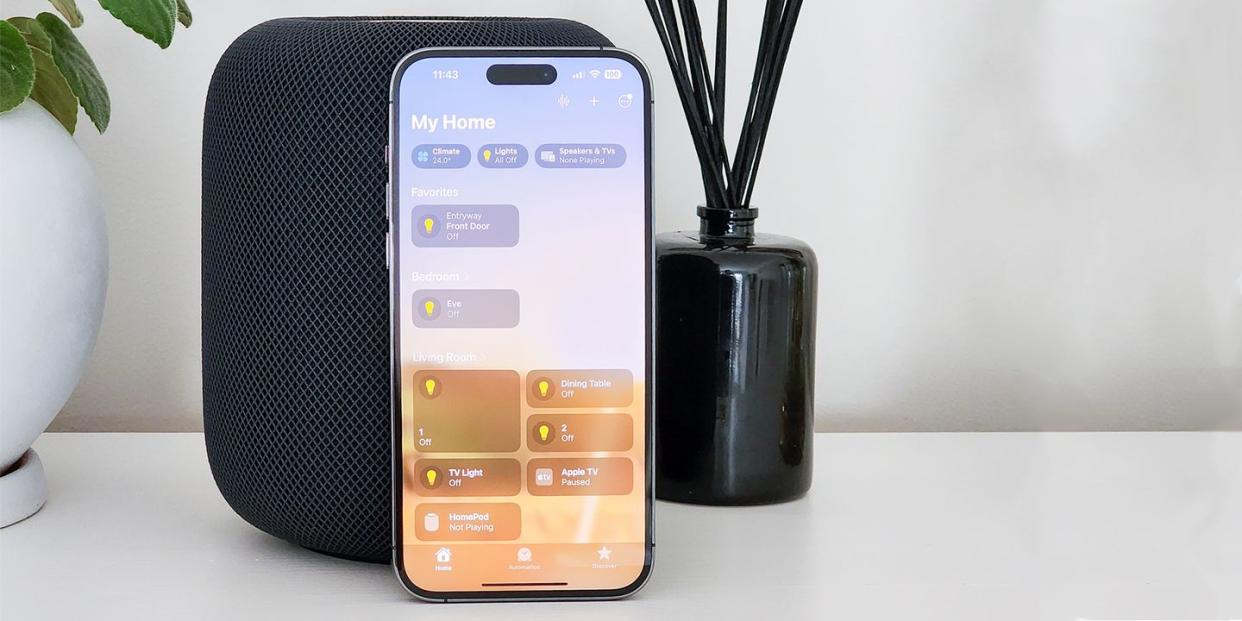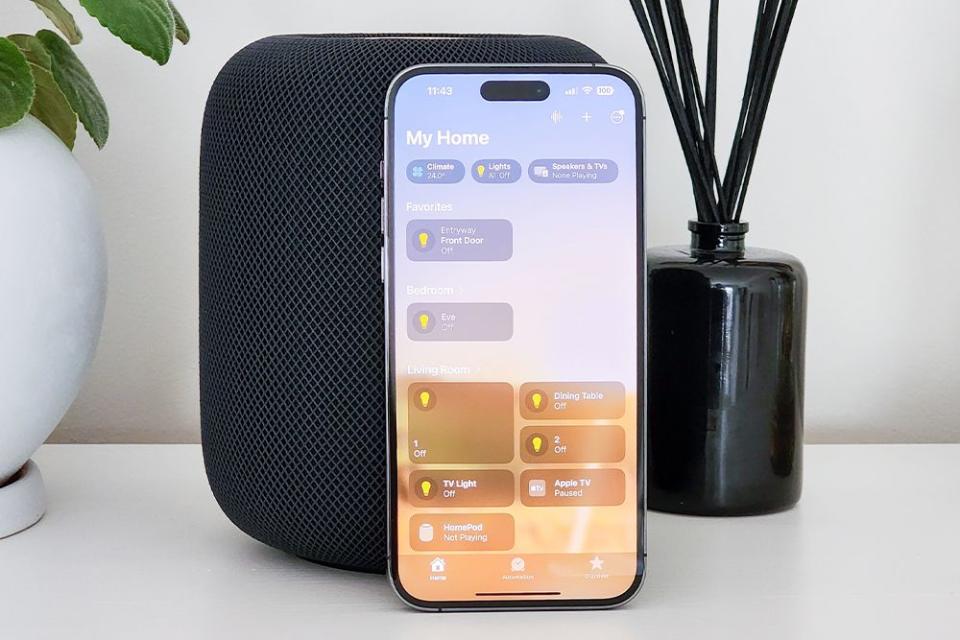Why the New Apple HomePod Is the Best Smart Speaker for Apple Users

"Hearst Magazines and Yahoo may earn commission or revenue on some items through these links."
More than half a decade (aka an eternity by consumer tech standards) after the original Apple HomePod debuted, the second generation has finally arrived. Apple showcased its first-ever smart speaker during WWDC in 2017, and the product hit the shelves in early 2018 with best-in-class sound, Siri, HomeKit integration, and a hefty price tag. A smaller and much cheaper HomePod mini followed in late 2020, just a few months before its larger sibling was officially discontinued.
Two years later, the HomePod sequel is here with the same instantly recognizable design (only a fraction of an inch shorter than the original), revamped hardware for better audio performance, and improved connected home capabilities. The newcomer’s $299 sticker is $50 lower than its predecessor’s at launch, though still high by today’s smart speaker standards.

HomePod (2nd Generation)
$299.00
walmart.com
walmart.comI’ve tested the new HomePod for a week, and it’s nothing short of excellent. By addressing the shortcomings of the previous iteration, expanding its everyday usability, and lowering its price, Apple made the follow-up worth the long wait and considerable cost. Here’s why:
Fantastic Audio Quality
The audio quality of the HomePod is phenomenal and, like that of the previous version, an industry benchmark. Equipped with five tweeters and a massive high-excursion woofer, the speaker delivers a rich, immersive, and infinitely enjoyable sound across the audible frequency range. Regardless of the content — from classical to vocal jazz to beats-infused trip-hop tracks, the speaker produced a vibrant treble, a harmonious midrange, and powerful-yet-accurate bass.

Impressively, the new HomePod sounds better than the original despite packing fewer tweeters (5 vs. 7). I was particularly taken by the power and accuracy of its bass, even at high volume levels. The first-generation HomePod tended to become boomy in such scenarios. The low-range delivery of the sequel is noticeably more contained, allowing the vocals and the instrumentals to shine without skimping on power and accuracy.
The acoustic prowess of the new HomePod is driven by the Apple S7 chip — the same that powers the Apple Watch Series 7 — and an internal bass microphone — a pair of invisible but essential hardware bits. The former optimizes the acoustic performance of the speaker in real-time based on its surroundings and the content that’s playing. It is based on the A13 Bionic chip of the iPhone 11, so it’s generations (and years) ahead of the Apple A8 chip inside the original HomePod.
On the other hand, the internal bass microphone keeps tabs on and calibrates the lows for consistently excellent output. For comparison, the bass delivery of the original HomePod, while undeniably entertaining, didn’t match the fidelity and precision of its successor.
Connecting a duo of HomePods in a stereo pair results in a breathtaking sonic experience. The power and levels of detail such an arrangement delivers can outperform audio systems that cost more and are nowhere near as space-efficient and easy to set up.

Two HomePods, in tandem with the latest Apple TV 4K streaming player, can also output home theater sound, including Dolby Atmos-enhanced content. During my testing, I replaced a top-shelf soundbar and liked the sonic experience a lot — the levels of immersion brought by the double-digit amount of audio drivers between the two Apple speakers were on another level.
The HomePod’s home theater capabilities don’t end by connecting it to an Apple TV 4K. Once linked to the media player, the speaker will work with other hardware that uses the same TV (e.g., cable box, video game console, etc.).
The quartet of microphones onboard the new HomePod performed in line with my high expectations. The speaker picked up all my “Hey, Siri” voice commands, even when the music was blaring at high volume levels. It performed admirably during calls, too.
A Connected Home Powerhouse
The HomePod has always been a powerful and secure smart home hub, and the latest one is no exception. The speaker can link to and control countless HomeKit home accessories, including connected plugs, smart locks, and security cameras, among many others. Setting up and managing these gadgets is quick and easy via the Home app for iPhone and iPad — there’s no need to spend big, install more apps, or create accounts to get started.

Support for the Matter smart home standard is a new feature that makes the new HomePod a futureproof buy. The new protocol was developed by industry giants, including Apple, Amazon, Google, and Samsung, to name a few, and compatible products began hitting the retail shelves. The Matter ecosystem will only grow in the months and years ahead, so you won’t be lacking in smart home offerings that will work with the HomePod.
By adding temperature and humidity sensors, Apple made the new HomePod a mightier connected home tool. In addition to keeping tabs on your indoor climate, the sensors can prompt home automation routines. For example, the HomePod will adjust your smart thermostat when the temperature reaches your chosen level.
Sound detection is an upcoming HomePod feature to look forward to. Set to arrive in the coming months, the functionality will allow the device to alert you about alarm noises while away from home via notifications on your iPhone or iPad. You’ll be able to hear it and check if everything is in order if you have a camera.
Wrap-Up
The new HomePod is hands-down the best smart speaker for Apple users. Its exceptional sound quality, ease of use, and vast smart home capabilities are worth pressing the buy button, especially if you have already bought into the Apple universe.
If you already own an Apple device like an iPhone or iPad but haven’t taken the connected-home leap yet, the HomePod is the centerpiece to get if it fits your budget. Its acoustic excellence, together with the easy-to-access features it offers, will constantly remind you of money well spent.
Consider the HomePod mini if the Apple smart home convenience is a priority but you don’t want to drop $300. For less than $100, the smaller speaker will bring similar smart home functionality, including active temperature and humidity sensors (Apple enabled them via iOS 16.3), Matter support, and upcoming sound detection.
You Might Also Like

